When I moved to Santa Monica, I noticed how people talked about their gyms. I’d hear things like:
“I’m obsessed”
“It’s my sanctuary”
It’s not just LA. In cities across America, fitness is becoming intertwined with spirituality. A church in Minnesota built a gym in its basement and calls itself “a church with muscle." A rabbi in Saratoga, California, leads a combination prayer service and workout class called “Body & Soul.”
A popular opinion today is that the wellness industry is filling the void left by organized religion.
In an age of declining religiosity, the gym does for many people what organized religion used to do. Fitness classes like CrossFit and SoulCycle provide meaning, purpose, ritual, and fellowship. They offer possibilities of transcendence and self-actualization.
How did gym become the new church?
In this piece, I’ll explore how the fitness world is embracing spirituality; how today’s gyms facilitate social bonding and group flow states — and what’s gained or lost when the gym replaces the church.
The SoulCycle Effect
I recently met Julie Rice, co-founder of SoulCycle, at an event in New York City.
SoulCycle, founded in 2006, built a cult-like following by designing an experience that combined fitness with community and spirituality. They hired instructors that radiated charisma and star power. You’d leave a SoulCycle class feeling like you’d had a religious experience.
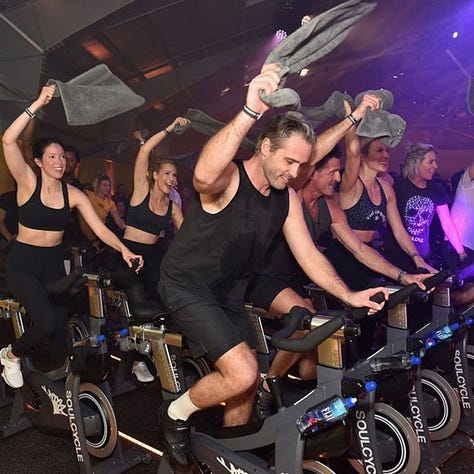

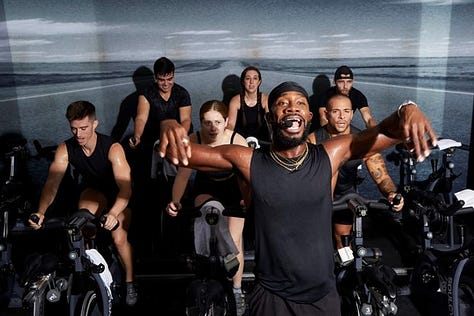
SoulCycle members describe their instructors as “inspiring” and “life-changing.” The effect is to recreate a church-like feeling of spiritual connection and group transcendence.
Some types of fitness, like yoga, have always had a spiritual component. For gyms like SoulCycle, it was a brilliant way to stand out in the competitive fitness space.
There are plenty of ways to break a sweat and burn calories. Why not do it in a way that makes people feel euphoric and spiritually fulfilled?
Tackling the Loneliness Epidemic
As traditional religious attendance declines, people are seeking meaning, purpose, and community elsewhere.
Enter: The modern gym.
Today’s gyms aim to make you feel connected to people around you. To make you feel like you’re part of a tribe.
This is the “loneliest time in human history,” says Airbnb CEO Brian Chesky. US Surgeon General Vivek Murthy has described loneliness as an epidemic, on par with tobacco use and obesity.
People don’t gather as much as they used to. They’re working remotely instead of in the office. Shopping on Amazon instead of in a mall. Watching movies on Netflix instead of in theaters.
Church attendance has declined. Over the past 25 years, about 40 million American adults have stopped going to church.
The most common replacements for traditional worship: Spending time in nature, meditation and physical activity. Things that get you out of your head and the anxieties of the material world.
Places like churches are no longer what they were in terms of gathering, but we still need community. We need to be physically together.
What’s filling the void? Increasingly, it’s things like yoga, SoulCycle, and CrossFit.
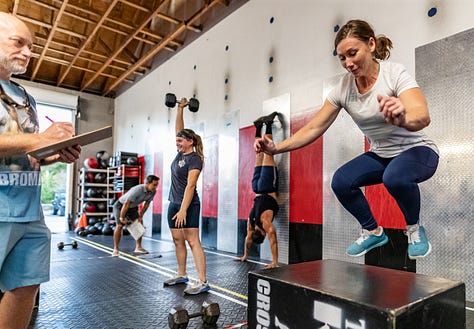

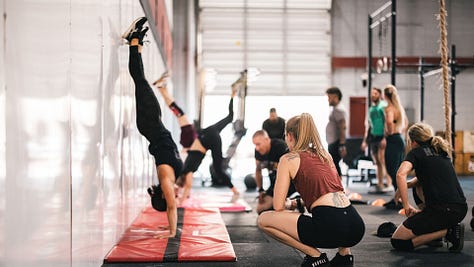
Community and Belonging
I’ve made more friends at my local gym than just about any other local community.
A good gym can foster deep relationships in a way that other spaces, like bars, can’t. There’s something about going through an experience that tests your limits, especially if you’re doing partner or team-based fitness routines, that leads to bonding and friendship.
An Oxford study shows exercise’s mood-enhancing endorphins and serotonin may be responsible for some of the group bonding that happens in the gym:
“Experiencing exercise-induced natural highs with others leads to a sort of “social high” that facilitates group bonding, friendship, and cooperative behavior.”
For many people, the gym has replaced the church (or synagogue or mosque) as the communal gathering spot.
Rina Raphael, author of “The Gospel of Wellness,” said:
“The message of gyms and fitness studios seems to be: If you’re lonely, go to the gym and you’ll have your friends right there. You don’t need to make plans with people, you just show up and your friends are there, like it was for our grandparents going to church.”
The gym you belong to has become a marker of your identity. “I do CrossFit” — these words signal you’re a member of a certain tribe.
Clothing and accessories are important markers of tribal identity. Just as church-goers wear certain garments to symbolize their affiliation, gyms have their own signature apparel: yoga mats, athleisurewear, cross-training sneakers.
These physical symbols help build community. They show you’re part of the tribe.
Purpose and Ritual
My gym in Santa Monica, Allegiate, offers a class called Arm Farm. Picture 24 people gathered in a darkly-lit room, bathed in fog and lasers. A traditional Japanese war drummer hammers on a Taiko drum. There’s a warpaint station so you can put on face paint. People move in unison to the steady beat of the drum. It feels like a tribal ritual.

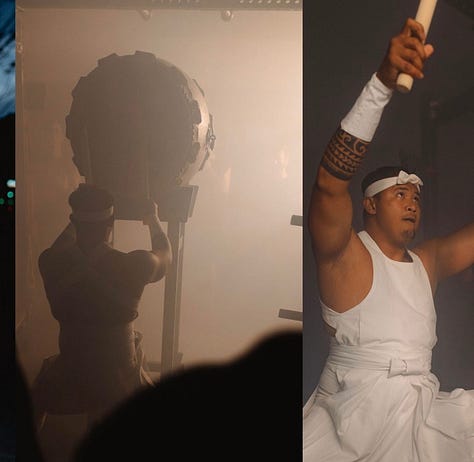




Tim Caron, co-founder and head coach at Allegiate, told me:
“My graduate school had the ethos of Spirit Mind Body. We used to joke about periodizing your spiritual and mental training the same way we would with performance training. Who would have thought that we would now have the opportunity to actually do that?”
This new breed of fitness studio is using rituals to transform a workout into a spiritual experience. They hold the promise of connecting with a deeper meaning or purpose. Transcendence.
John Foley, founder of Peloton, said:
“People still want that guidance and ritual and identification and community and music and ceremony and spirituality and reflection — the stuff that happens on Sunday morning at church, or in your synagogue.”
SoulCycle talks about how people “come for the body but stay for the breakthrough.” These gyms create fitness experiences designed to help people gain new insights, clarity about what’s important to them, or a renewed commitment to their goals in life.
Anyone who’s been to SoulCycle knows there’s something about the combination of music with movement and lighting that contributes to an altered state. Like an EDM concert, modern fitness studios can inspire strong emotions and transcendent collective experiences. We submit to the leader, get outside of our heads and enter a group flow state.
Casper ter Kuile, author of “How We Gather,” studied CrossFit and SoulCycle as a student at Harvard Divinity School. He writes:
“Ritual is a connective tissue tool. It de-centers the individual and centers the collective in a way that I think is healthy. Ritual de-centers our immediate priorities and re-centers something else. Ritual gives us a rhythm in a world where we’ve lost so many of the traditional markers of time.”
Not all fitness pros are embracing the trend. I asked a well-known fitness influencer if he thought gyms should be in the business of spiritual wellness. “Hell no,” he said. “A gym is for training. Your relationship with the divine is personal.”
What’s Missing
The big question: Is the gym an adequate replacement for traditional religious institutions? The answer isn't straightforward. While gyms offer community and transcendent experiences, they may fall short in other areas:
Depth: The depth of spiritual experience doesn’t match what people can get from organized religion. SoulCycle members may get feelings of transcendence, but those feelings are fleeting when compared to the deeper, lasting transcendence of religious practice.
Community Bonds: It’s great that gyms are offering people fellowship and community. But a gym’s social connections are often shallower. You don’t get the same deep-rooted sense of belonging. If you get sick, you’re unlikely to get the same love and care from your gym buddies that a church congregation would give to a member of their flock.
Inclusivity: One downside of relying on a fitness class for your community is that you're excluded when you're no longer able to participate. Churches do a better job of continuing to include members as they age or become disabled.
Spiritual Technologies
Religions can be seen as “spiritual technologies,” says Dr. Lisa Miller, professor of Psychology at Columbia University and Founder and Director of the Spirituality Mind Body Institute.
Study after study has shown people who are engaged in spiritual practices love longer, healthier and happier lives.
Dr. Miller says:
“Whether you consider yourself a spiritual person, or not, your brain is wired for spirituality in a way you never imagined. There is some wisdom in those practices that helps us meet the challenges of life.
Life hacks are like chopsticks. Religions are playing symphonies. They put together many different hacks in one practice: The way you breathe controls your physiology. The prayers you’re saying alter your thinking, in very sophisticated ways, to help us deal with challenges, from grief to finding joy and meaning.”
The Future of Gyms
Gyms will never be a complete replacement for the church. Organized religion evolved over millennia. Even the most cult-like yoga studio can’t hope to compete with Christianity or Catholicism.
So, what's the future of "spiritual fitness"?
Imagine a gym that offers:
An environment that’s uplifting and inspiring
It stimulates all your senses, combining movement with music and lighting in perfect harmony
The instructors give you a sense of belonging, meaning, and purpose
Rituals make it a beautiful, spiritual experience
The coaches help you become more resilient, so you can deal with challenges in sophisticated ways
An experience of transcendence or ego dissolution so you feel connected to something greater than yourself
The members feel like a family and truly support each other — both inside and outside the gym
That’s what I see as the future of gyms. That’s my vision for a spiritual wellness community.
I’d love to hear your thoughts. Should gyms be focused on spiritual wellness? How can we create spaces that truly fulfill our deepest human needs?
Thank you for reading this week’s edition of Vitamin Z.
Until next time,
By Daniel Zahler
Hi there and thanks for reading. I created Vitamin Z to share my research on health and wellness, longevity and healthy aging, and ways to optimize cognitive, physical and emotional health. I serve as an advisor to Noom, a leading digital health company, and work with the world’s top healthcare and life sciences companies to develop innovative new solutions to improve health globally. I was trained as a research scientist at Harvard, and I serve as a GLG council member, where I advise global business leaders on healthcare and technology innovation.
Enjoyed your reading experience?

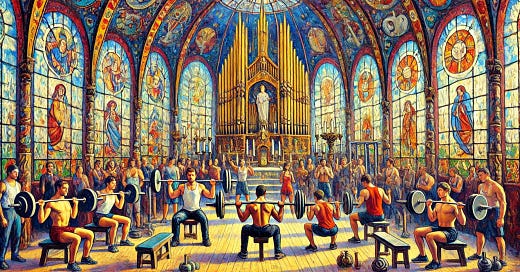



I nerver thought of this angle - nice one! I have had the same experience joining a bootcamp group. We were about 50 people working out together with a coach. I very much enjoyed it and it was from this group I made most of my friends during this time. It definitely gave a sense of purpose and fun.